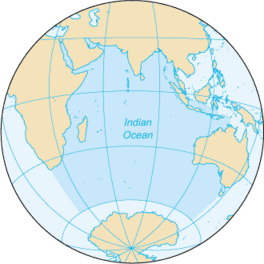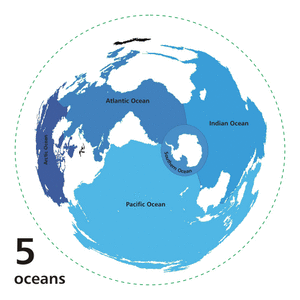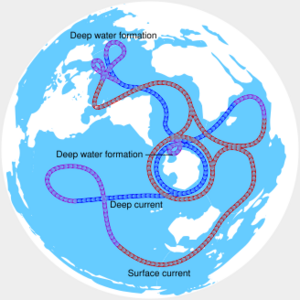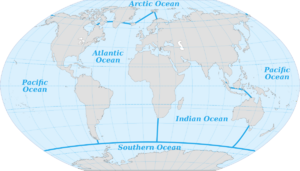Indian Ocean facts for kids
Quick facts for kids Indian Ocean |
|
|---|---|

Extent of the Indian Ocean according to The World Factbook
|
|
| Location | South Asia, Southeast Asia, Western Asia, Northeast Africa, East Africa, Southern Africa and Australia |
| Coordinates | 20°S 80°E / 20°S 80°E |
| Type | Ocean |
| Max. width | 6,200 mi (10,000 km) |
| Surface area | 70,560,000 km2 (27,240,000 sq mi) |
| Average depth | 3,741 m (12,274 ft) |
| Max. depth | 7,906 m (25,938 ft) |
| Earth's ocean |
|---|
|
Main five oceans division:
Further subdivision: Marginal seas |
The Indian Ocean is the third largest ocean on Earth. It covers about 70,560,000 square kilometers. That's about 20% of all the water on our planet!
This huge ocean is surrounded by different continents. Asia is to its north, Africa to its west, and Australia to its east. To the south, it meets the Southern Ocean or Antarctica. The Indian Ocean gets its name from the country India.
The deepest part of the Indian Ocean is the Java Trench. It's near the Sunda Islands in the east. This trench is about 7,906 meters (25,938 feet) deep. On average, the ocean is about 3,741 meters (12,274 feet) deep. Most of the Indian Ocean is in the Southern Hemisphere.
Contents
The Warmest Ocean: Indian Ocean Climate
The Indian Ocean is the warmest ocean in the world. Records show that it has been getting warmer quickly. From 1901 to 2012, its temperature went up by about 0.7 to 1.2 degrees Celsius. This warming is happening faster here than in other tropical oceans. It's about three times faster than the warming seen in the Pacific Ocean.
Scientists believe that human activities are causing this warming. Things like the greenhouse effect and changes in El Niño events are making the Indian Ocean hotter.
Amazing Marine Life
The western Indian Ocean is home to many tiny plant-like organisms called phytoplankton. These tiny plants grow a lot in summer. This is because of the strong monsoon winds that blow across the ocean.
The Indian Ocean is very important for fishing. It provides a large amount of tuna, which is a valuable fish. Countries near the ocean rely on its fish for food and to sell to other places. Fishing fleets from countries like Russia, Japan, South Korea, and Taiwan also fish here. They mainly catch shrimp and tuna.
Sadly, rising ocean temperatures are harming the ocean's living things. Studies show that the amount of phytoplankton in the Indian Ocean has dropped by 20% in the last 60 years. The number of tuna caught has also gone down. This is due to more industrial fishing and the ocean getting warmer.
Some amazing animals in the Indian Ocean are now endangered. These include the dugong, seals, turtles, and whales.
The Indian Ocean Garbage Patch
In 2010, scientists found a huge area of plastic garbage in the Indian Ocean. It's called the Indian Ocean garbage patch. This patch covers at least 5 million square kilometers. It's like a giant swirling pool of trash. The plastic travels from Australia to Africa, then down the Mozambique Channel, and back to Australia. This journey takes about six years.
New Discoveries Underwater
In 2016, researchers from Southampton University in the UK found something amazing. They discovered six new animal species living near hydrothermal vents deep under the Indian Ocean. Hydrothermal vents are like hot springs on the ocean floor. The new species they found include a "Hoff" crab, a "giant peltospirid" snail, a whelk-like snail, a limpet, a scaleworm, and a polychaete worm.
Images for kids
-
The Indian Ocean, as seen by the CIA The World Factbook (blue area), and as defined by the IHO (black outline - not including smaller water bodies).
-
Animals that lived on islands in the Indian Ocean: Madagascar's Elephant bird, Mauritius's Dodo bird, and an ostrich (from left to right).
-
The important Silk Road was blocked by the Ottoman Empire around 1453. This led explorers to find new sea routes around Africa, starting the Age of Discovery.
-
Malé's population grew from 20,000 people in 1987 to over 220,000 people in 2020.
-
A man from the Chagos Islands on Diego Garcia in 1971. The British later moved the islanders when the island became a U.S. military base. His family likely came to the island as slaves in the 1800s.
-
Mombasa Port on Kenya's Indian Ocean coast.
See also
 In Spanish: Océano Índico para niños
In Spanish: Océano Índico para niños

















